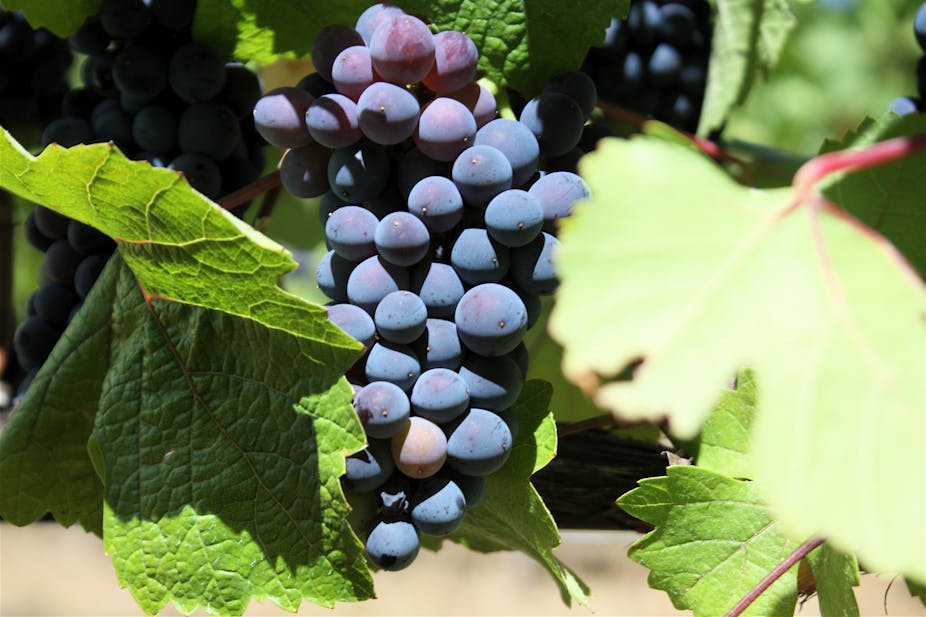The diversity within grapevine varieties is incredibly rich. This is good news for viticulturists – grape cultivators – and wine makers because it allows them to adapt their wine production according to the conditions in their vineyards and to the wines they want to make.
Pinot is one of the most ancient grapevine varieties and the Pinot family is an invaluable source for the production of a wide range of wines from around the world. There’s the Pinot noir from Burgundy, California or New Zealand, Pinot Meunier in Champagne, Pinot gris in Alsace or Pinot blanc in Italy.

The vine stocks used in viticulture are obtained by grafting. It means that for any given variety, all stocks are identical – or almost all. Spontaneous events in the genomes of some vines can arise which leads to differences between individual plants.
Along with colleagues, we’ve been studying the fascinating Pinot family for 15 years at a special wine research unit at INRA Colmar, in France. In a new study, published in PLOS Genetics, we revealed for the first time the molecular and cellular mechanisms that lead to differences between plants of the Pinot family. And, in particular, on the spontaneous mutations that underpin the change of berry colour.
Spontaneous mutations
A unique chromosomal region in the grapevine genome controls berry colour. Two genes located in this region can induce the biosynthesis pathway – the biochemical reactions that create anthocyanins, the complex red pigment molecules that give a grape variety its berry colour. But when the two genes are inactivated by a mutation, this pathway stays switched off and the variety is white (as Pinot blanc).

Almost all coloured varieties, including Pinot noir, display both the active (leading to the black colour) and the inactive form of these genes. Through a detailed molecular analysis of a collection of 33 clones of Pinot noir, Pinot gris and Pinot blanc, we showed that large-scale exchanges between the maternal and paternal (homologous) chromosomes in the grape, leads to the replacement of the chromosomal region that enables the creation of anthocyanins by the corresponding region on the other chromosome that prevents it.
Thanks to this transfer of information between these two chromosomes, which is a rare naturally occurring event, Pinot blanc-type cells can emerge from a Pinot noir. In the 33 clones we studied, we identified four new chromosomes displaying independent replacements that were responsible for the loss of the anthocyanin-making mechanism, with a size reaching up to a quarter of the length of the entire chromosome.
After occurring in a cell, these mutations then propagate progressively to form a distinct cell layer in the shoot, leading to what is called chimeric plants. This is how Pinot gris arises from Pinot noir: a Pinot noir skin surrounds internal cells that have mutated to Pinot blanc. All of the known Pinot gris are chimeras that associate these two types of tissues.

In a previous study, we reported multiple occurrences of chimerism by using molecular markers. Such cellular structures do not threaten the plant’s fitness and stay stable through vegetative propagation of the plant by grafting.
Occasionally, cellular rearrangements in the chimera lead to the homogenisation of the whole plant. This is how Pinot blanc can emerge from a Pinot gris – when the internal mutated cells invade the coloured skin, which then spreads the mutations throughout the plant.
Diversity within varieties is the result of a series of rare events. It implies that a mutation must first occur in a cell that is, or will become, part of the shoot. Then the mutated cell must multiply to form a distinct cell layer. If it is formed, the chimera must then survive the annual pruning of shoots and be selected for vegetative propagation.
In this study, berry colour was used as a model trait to shed light on the molecular and cellular mechanisms behind the colour variations of the Pinot family. Through these mechanisms, the grapevine stocks drift over time and grapevine genome evolves. Of course, similar molecular and cellular mechanisms may impact other propagated plants, which creates diversity.
Viticulturists can only select these very rare events when they observe them (though some viticulturists pretend to have selected specific stocks fully adapted to their terroir, it is possible that they use diversity created by spontaneous mutations). But the diversity created when these mutations happen are great for creating flavour – the difference, for example, between a chardonnay and chardonnay muscaté. There are also different clones of Syrah that show very different levels of resistance to the Syrah decline (a disease) – a result of this clonal diversity.

